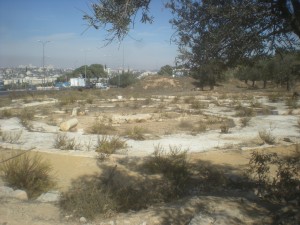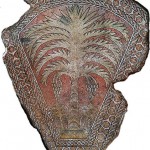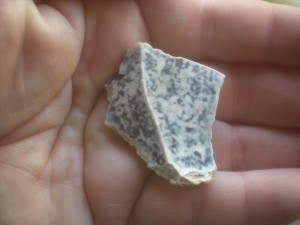
Construction in Israel is always a difficult endeavor. In a country with as long a history as ours is, every time a spade or backhoe touches earth, there is the chance (or even the likelihood) that you will come across finds of archaeological significance. And when you do, construction grinds to a halt until the archaeologists can come in and examine the finds, determining whether they are significant, and whether construction can even continue there at all.
In recent years, building expansions have uncovered an ancient church at the site of a modern prison and an ancient cemetery near a hospital. In both cases, the building plans were halted until solutions could be found. Sometimes the archaeological site will be preserved at the location so people can see the finds in situ — where they were found, and construction will be abandoned. Other times, they will be covered and preserved underground, with the construction proceeding above the site. And sometimes the material will simply be removed and catalogued for later research.
I’ve recently visited a few of these types of sites, all within the boundaries of modern Jerusalem. It is yet another reason why I love living here. I am constantly surprised by the history and archaeology that you practically trip over every time you walk around this magnificent city.
Kathisma
Derech Hevron, or Hebron Road, runs along the same path (more or less) of an ancient highway. Referred to by modern scholars as the “watershed route” or the “spine route,” it ran the length of much of the country, north-south, along the top of the mountain range. I live approximately a 5 minute walk from this road, on a stretch that runs between ancient Jerusalem (or technically a drop west of it) to the north and Bethlehem to the south.

If you drive into Jerusalem from the south and drive up Derech Hevron, you will soon pass a monastery (Mar Elias) on your right, and come to a traffic light. A bit past the traffic light you can see a gas station. Between the light and the gas station, if you look to your right, you can see some archaeological remains. Thousands of people pass this location every day. Many probably never even notice it, and of those who do, few know what it is.
The site shows the outline of an octagonal building, with a few concentric rings. At the center, there is a piece of bedrock sticking out of the ground. There are also a number of rectangular chambers with one side curved. The site was discovered when machines were digging to widen the road here.
It turns out, that the site is actually a 5th century Byzantine church known as Kathisma. It had been written about in Byzantine sources, and thus people knew it existed, but no one knew where it was! The church commemorates a spot where Mary sat as she was heading south. It is unclear whether this was when she was on her way to Bethlehem from Nazareth, before Jesus was born, or whether it was when the family fled to Egypt to escape Herod Antipas, after Jesus’ birth. So the church was actually associated with both events.
The rectangular chambers are actually chapels, and there were also a number of beautiful mosaics discovered here, all of which have now been covered up to preserve them. For more information on this church, as well as a floor plan, you can check out this page at the Israel Ministry of Foreign Affairs website, or this Hebrew page from Wikipedia (the images are good, even if you can’t read Hebrew).
Malha
In the southern portion of modern Jerusalem lies a fairly industrial area known as Malha. Among other things there, you can find Jerusalem’s zoo, the Technological Park where many internet companies have offices, and Teddy Stadium, the soccer stadium named for this city’s beloved former mayor Teddy Kollek. Sandwiched between the stadium and the Technological Park is the city’s largest shopping mall. It is a highly trafficked area, and I’ve been there many times.

Recently, our class visited the mall during one of our weekly trips. “A tourguide class taking a trip to the mall?” you wonder. Well you’d be right to ask, if I meant anything more than a stop for lunch (which we also did there). But in fact I do mean something more.
At the northern end of the parking lot, on a little hill (which may be why so few people know about it), lies the remains of a number of small building foundations. I have asked a number of Jerusalemites, including both tour guides and people who work in the mall itself, and I have yet to find one who even knows this site exists (though I am sure some people do know about it).
What we have there are the remains of houses from a small village from the Middle Bronze era. Basically, we are talking about a nearly 4000 year old site. The truth is that there isn’t a lot to see there, other than a few wall and pillar foundations. But the fact that this ancient site lies out in the open, and nobody even knows it exists, simply blows me away.
Arnona Hadasha
Saving the best, or at least the least known, for last. This next one is both brand new, and the oldest of them all.
Last Friday, I was sitting in class learning Prehistory from the well known Jerusalem-based archaeologist Dr. Gabi Barkay. He mentioned a recent discovery of Paleolithic, or Stone Age, remains on a Jerusalem street in an area known as Arnona Hadasha, or New Arnona. All of a sudden I blurted out, “That’s my street!”

So I stopped by the dig site today (it is about a 30-second walk from my building) to see what I could learn. As it turns out, they were doing construction there to build a new synagogue and came across the site. They are currently in the middle of a month-long salvage dig that has only about a week left. Then construction will resume. Unfortunately, I was not allowed to photograph inside the site, but the archaeologist on site, a nice guy named Dr. Omri Barzilai, showed me around and explained everything to me.
When they were first doing construction for my building complex, they came across a large number of flint tools, dated to the Middle Paleolithic era (250,000 – 50,000 years B.P., or Before Present). Omri did that excavation as well. There was no real order to anything there. Still, they presumed due to the number that there was a nearby source.
At the current site, I saw a cut in the ground that was approximately 30-50 feet deep. In it, I could clearly see a few layers. The top layer, about 10-15 feet thick was just soil. Beneath it, running along the entire edge of the site, I could easily make out a whitish layer that is the bedrock. Omri pointed out that in one section they found a depression, and between the bedrock and the alluvial soil on top I could easily see a large deposit of flint. The various layers are very easy to make out even to the untrained eye.

Omri’s theory is that this was a workshop of sorts, a quarry and source of tools for an ancient people. He believes they may be the same (previously discovered) people who occupied some caves about 10 miles to the southeast, near Herodion.
Additionally, since it was clear that the line of bedrock slopes down from here in the direction of my apartment building, he thinks that the tools they found there previously probably simply washed down there over time. Way down at the bottom of the hill I live near the top of is a valley known as Emek Refaim. Previously a number of artifacts from the same era were found there. Omri believes that since there was a wadi (drainage stream) that runs down from my area to Emek Refaim, many of the tools found there may have come from here. Either they may have washed down in rains, or they may have fallen down during tectonic activity (some were too large to have been washed down by rains).
The Emek Refaim site was also discussed today in this post about ancient sites in Jerusalem on GoJerusalem.com. And for a bit more info on it, check out this older story from Ha’aretz newspaper.
How cool that such an ancient site is just seconds from my house?! This is what it means to live in Jerusalem, and in Israel in general. Keep your eyes open, and you never know what you might find!

Great posts! Thanks for all the info and advice; I just started the tourguide course. As we say, l’hitra’ot bashetach!
Nice! Which course did you begin?
Really nice informative article, I enjoyed the read, given its significant and sometimes colourful/controversial history, what a great country to be an archeologist or historian. Mr Mapperley from West Bridgford